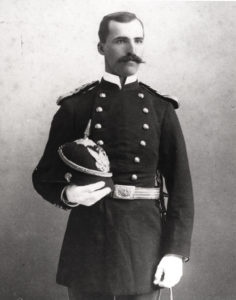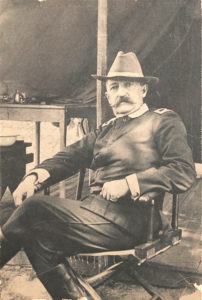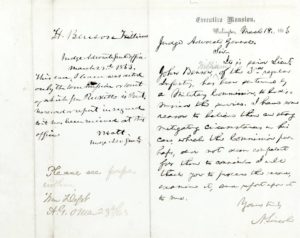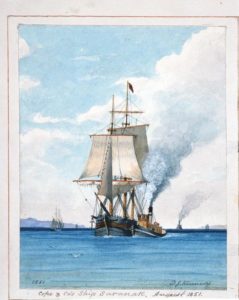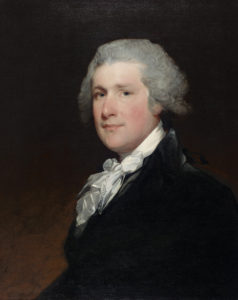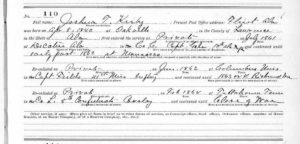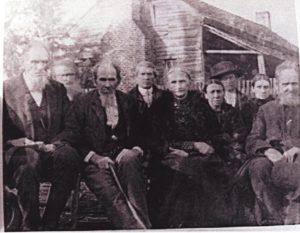Col Thomas M Anderson and family (c. 1897)
24 January 2023
Captain Thomas McArthur Anderson commanded a battalion of the 12th United States Infantry in action between the middle bridge over the Antietam and the town of Sharpsburg on 17 September 1862. Many years later, after a long and arduous Army career, he was Colonel of the 14th US Infantry and commanded Fort Vancouver, Washington (1886 to 1898).
Here he is with his family on “Officer’s Row” there in late 1897 or early 1898, before he was appointed Brigadier General and deployed to the Philippines on Spanish-American War service.
(back, left to right)
Thomas McArthur Anderson (1836 – 1917)
Elizabeth Van Winkle Anderson (1850-1914)
Charles Van Winkle (1821-1907)
(children, by age; I can’t tell the daughters apart)
Arline Anderson (later Cairns, 1871-1932)
Mary Anderson Allen (1874-1904)
Thomas McArthur Anderson, Jr. (1875-1936)
Elizabeth Anderson (later Gauld, 1875?-1944)
Van Winkle Anderson (1877-1960)
Irmengarde Anderson (later Patten, 1879-1945)
dog, name not known
Notes
This lovely picture accompanies a piece from the US Park Service called The Waking of a Military Town: Vancouver, Washington and the Vancouver National Historic Reserve, 1898-1920 [online in PDF]. The original photograph is in the University of Washington Libraries, Special Collections (UW475).
There’s another family portrait of the same period – and much more about the Andersons – in the 1973 monograph Thomas Anderson: First U.S. General Overseas for the Fort Vancouver Historical Society by General Anderson’s grandson Dr. Charles Anderson Gauld (1911-1977) [online PDF].
Thomas McArthur Anderson, Jr. had 4 years enlisted service in the 4th US Cavalry in Texas before being commissioned 2nd Lieutenant, 8th US Infantry on 8 June 1897, the uniform in which he is seen in the family photograph here. He served through WWI and retired as a Colonel.
Jacob Ford Kent (c. 1863, 1885, 1891, 1898, c. 1918)
23 January 2023
United States Military Academy graduate J. (Jacob) Ford Kent (May 1861) had a very long, impressive military career and maintained an impressive mustache for even longer.
He was first in combat at Bull Run in July 1861 and was wounded and captured there, but was exchanged in time to rejoin his regiment, the 3rd United States Infantry, on the 1862 Maryland Campaign. He was a staff officer for most of the rest of the Civil War and in nearly continuous action to the end.
He was afterward an instructor at the Academy and served at posts in the West and South over a span of nearly 30 years right up to the Spanish-American War.
Here he is, mid-career, as a Captain in dress uniform in about 1885.
In January 1891 he was serving again as an Inspector General, by then a Major, and his boss General Nelson A Miles detailed him with another officer, Captain Frank D. Baldwin, to investigate the recent fight of the 7th US Cavalry at Wounded Knee in South Dakota.
His facial hair makes him easy to pick out in this photograph of General Miles and staff taken that month at the scene of what has since become known as the Massacre at Wounded Knee (touch to enlarge).
On 1 July 1898, by then a Brigadier General of Volunteers, he led a Division in the famous and successful charge up San Juan Hill near Santiago, Cuba in the war with Spain. Still sporting a serious mustache.
He retired as a Brigadier General, US Army in October 1898 and still looked to be in fighting shape to near the end of his life in 1918. Here he is in a late-life photograph published by the USMA Association of Graduates in 1919:
_________________
Notes
The photograph at the top is a CDV of Kent, probably taken while he was serving as Lieutenant Colonel and Inspector General of Volunteers with the Sixth Army Corps, from 1863 to 1865; it was sold by The Horse Soldier of Gettysburg.
The 1885 photograph is from the National Park Service, Lake Roosevelt National Recreation Area, Washington, and was probably taken while Captain Kent was at Fort Spokane. It’s online in the NPGallery.
The 1891 group photograph of General Miles and staff was shared online by Sam Russell in a piece called Wounded Knee Investigation on his Army at Wounded Knee blog; an excellent source for much more detail about the Wounded Knee investigation and outcomes. Here’s Mr Russell’s caption for the photograph:
George E. Trager’s “Gen Miles and Staff during Late Indian War at Pine Ridge Agcy,” January 13, 1891. From left to right are Captain Ezra P. Ewers, Lieutenant John S. Mallory, Captain Francis E. Pierce, Lieutenant Colonel Dallas Bache, Captain Francis J. Ives, Major Jacob Ford Kent, Lieutenant Colonel Henry C. Corbin, Major General Nelson A. Miles, Captain Frank D. Baldwin, Lieutenant Sydney A. Cloman, Captain Charles F. Humphrey, and Captain Marion P. Maus. General Miles was the commanding general of the Division of the Missouri.
General Kent’s 1898 photograph was sold at auction by One Of A Kind Collectibles, Coral Gables, FL in 2012.
The last photograph is from the Fiftieth Annual Report of the Association of Graduates of the United States Military Academy, June 10, 1919.
A. Lincoln to JAG J. Holt 18 March 1863
22 January 2023
John Benson Williams, US Military Academy Class of May 1861, was First Lieutenant, 3rd United States Infantry at Antietam in September 1862, and commanded Company G there.
Antietam was the peak of his young military career, however, as he was sentenced by a Court Martial to be dismissed from the service in February 1863, having “left his command on the battlefield and returned to Washington, without leave and in known violation of orders and of his duty.”
In this note of 18 March 1863, President Lincoln, famously soft-hearted in these matters, asked Army Judge-Advocate General Joseph Holt to see if there weren’t mitigating circumstances that would allow him to return Lieutenant Williams to duty. He was presumably referring to Williams having been ill since sometime in December 1862:
The answer came back in the negative, Holt reiterating that Williams “has shown himself disqualified for the profession of arms,” so on 11 April 1863 the President endorsed the sentence of the Court, writing “I decline to interfere in Behalf of Lieut. Williams.”
_________________
Notes
Lieutenant Williams’ picture above is from a CDV sold on ebay, date unknown; it was captured and archived by Worthpoint.
The Lincoln letter was sold at auction by Sotheby’s in 2008. The image of it is from Sotheby’s, and details surrounding it are from Dr. James M. Cornelius, Curator, Lincoln Collection, Abraham Lincoln Presidential Library.
The original of this letter is again up for sale (as of January 2023), by Houle Rare Books and Autographs, with an online listing through Abe Books.
The President’s endorsement of 11 April 1863 is found in the Collected Works of Abraham Lincoln (1953), Vol. 6, pg. 169.
Cope and Co.’s Ship Saranak (1851)
21 January 2023
This is the packet ship Saranak of the Cope Line entering port with a steam tug at Philadelphia, PA in a brilliant watercolor by David Johnson Kennedy of August 1851.
Irish-born Antietam veteran Colwell Carr of the First Pennsylvania Reserves was a passenger on that ship from Liverpool to Philadelphia in May 1849. He settled in Media just west of the city and was a wool dyer at the start of the Civil War.
The tenth of Colwell and Mary Waugh Carr’s eleven children was Richard Isaac Downey Carr (1876-1963). I’d love to hear from anyone who knows about his Downey namesake.
_________________
The original of this painting is in the collection of the Historical Society of Philadelphia, and is online in their Digital Library.
See a little more about Thomas P Cope and his ships also online from the HSP.
Reno, Sumner, and Gilbert (c. 1866)
19 January 2023
Here’s a lovely photograph of 3 couples taken by Le Rue Lemer in Harrisburg, PA, probably in late 1866 or early 1867.
That’s Captain Marcus Albert Reno, First United States Cavalry, left front, and his wife Mary Hanna Ross (1843-1874; m. 1863), behind him. Reno commanded a detachment of the First Cavalry at Antietam at the headquarters of the Army of the Potomac, but is much better known for his role at Little Big Horn in 1874.
Back right is Edwin Vose Sumner, Jr. (1835-1912), also Captain in the First Cavalry. He was not at Antietam, though his father certainly was. That’s probably his wife Margaret Snodgrass Foster (1844-1910) to his right; they married in Harrisburg in January 1866.
The third man is identified as Harrisburg attorney Lyman DeHuff Gilbert (1845-1914, Yale ’65), who 13 years later, in 1879, successfully defended then-Major Reno before an Army court of inquiry into his actions at Little Big Horn. The third woman is not identified. Gilbert was unmarried and living with his wealthy parents at the 1870 US Census, so probably no wife in 1866.
________________
This photograph was sold by Heritage Auctions in 2007.
The Heritage cataloger identified Captain E.V. Sumner as son of Senator Charles Sumner, which is perhaps obviously incorrect. Not least because Senator Sumner didn’t marry until 1866, fathered no children, and was divorced in 1874.
Officers of the USMA Class of 1860 (August 1862)
18 January 2023
A new project: to identify the men in this Alexander Gardner photograph taken at Harrison’s Landing, VA in August 1862. Of special interest to me are those officers who were on the Maryland Campaign a month later (touch picture to enlarge).
#1 – Lt. James Harrison Wilson
#2 – Lt. Charles Edward Hazlett (’61)*
#4 – Lt. Nicholas Bowen?
#6 – Capt. William Graham Jones
#7 – Lt. Alexander Cummings McWhorter Pennington, Jr.
#9 – Lt. John Moulder Wilson
#10 – Lt. Alanson Merwin Randol
#11 – Capt. Josiah Holcomb Kellogg
There is obviously more work to do here.
———–
This image is part of the left half of a stereo photograph, displayed online by the Library of Congress, from their Civil War Photographs collection.
Other men of the Class of 1860 who may be in the picture above and were at Antietam, are:
– John Newman Andrews
– Daniel Darius Lynn
– James Porter Martin
Members of the Class of 1860 who were at/near Harrison’s Landing in August 1862, but perhaps not on the Maryland Campaign, are also candidates to be in the photograph:
– Lt. Horace Porter
– Lt. Sam A. Foster
– Lt. Alfred T. Smith
Math is not my strength, but if these six men are in the photograph, we’ve got names for 13 14. Unfortunately, I have not yet found wartime photographs to identify the six five remaining. Please let me know if you can help.
Alexander James & Arabella Smith Dallas (c. 1800)
17 January 2023
Alexander James Dallas III was at Antietam in 1862, a Captain in the Second Battalion, 12th United States Infantry. He was from a prominent family, as you might guess from these Gilbert Stuart portraits of his grandparents Alexander James Dallas (the First, 1759-1817) and Arabella Maria Smith Dallas (1761-1837). They were “one of the more fashionable couples in Philadelphia during Washington’s administration.”
Alexander I was later President James Madison’s Secretary of the Treasury and was briefly acting Secretary of War and of State.
Captain Dallas’ father Alexander II (1791–1844) was a US Navy Commander, and his mother was the former Henrietta Constantia Meade (1801-1831), older sister of George Gordon Meade. Another son of Alexander I was George Mifflin Dallas (1792-1864), James K Polk’s Vice President.
_______________
Alexander I’s original portrait is at the Pennsylvania Academy of Fine Arts in Philadelphia, Arabella’s is at Mount Vernon.
Poughkeepsie, NY Main Street (1860); S.H. Bogardus (1865)
12 January 2023
This would have been a familiar view for Stephen H Bogardus and his sons Stephen and Eliphalet (!) who worked together in the family’s saddle and harness shop about a block east on Main Street across from the Gregory House Hotel.
Stephen H Bogardus, Jr. enlisted in April 1861 in the 5th New York Infantry – the famous Duryée’s Zouaves – was promoted to Sergeant by October 1861 then commissioned 2nd Lieutenant in the Purnell Legion of Maryland, with whom he saw action at Antietam, where he was at least slightly wounded. He mustered out with the Legion in October 1864 and was briefly Captain of a Company he raised in Poughkeepsie, part of the 192nd New York Infantry, in 1865.
He was a Lieutenant in the Regular Army after the war, to 1871, then briefly back in the leather business in Poughkeepsie. By 1880 and for the rest of his life he was a railroad man with the Santa Fe in New Mexico Territory.
Here’s a fine photograph of him supplied to his memorial by the late Brian Pohanka, taken sometime after he was brevetted Major in 1865 for his war service.
The street scene above and the location of the Bogardus shop are from Edmund Platt’s The Eagle’s History of Poughkeepsie: from the earliest settlements, 1683 to 1905 (1905), which is online from the Internet Archive.
The Eagle refers to the local newspaper in which Stephen, Sr. was a frequent advertiser in 1860. Stephen, Jr. wrote often to the Eagle during the war, and those letters were edited and published in 2002 by Joel Craig as Dear Eagle: The Civil War Correspondence of Stephen H. Bogardus, Jr. to the Poughkeepsie Daily Eagle.
The Bogardus’ occupation from the 1860 US Census.
Eliphalet P Bogardus (1834-1929) was probably named for his uncle Eliphalet Price Bogardus, who died at age 13 in 1827. Eliphalet and his father were still in business together as S.H. Bogardus & Son in Poughkeepsie to at least 1872.
J.T. Kirby, Alabama Confederate Census (1907)
8 January 2023
Here’s the Rosetta Stone to my understanding of Joshua Taylor Kirby‘s varied Civil War military career. It’s his response to a survey of Confederate veterans the state of Alabama undertook in 1907 (and again in 1921 and 1927), now online from the FamilySearch database.
Kirby was a Private in Company K of the 2nd Mississippi Battalion in combat at Sharpsburg on 17 September 1862 [more about that]. The battalion gained companies to become the 48th (not 41st) Mississippi Regiment in November 1862, then Company K converted to cavalry in January 1863, as Company F, 8th Confederate Cavalry – Private Kirby’s fourth named unit.
Dulaney siblings (1905)
8 January 2023
Alfred (1808-1862) and Rachel McNeice (1812-1883) Dulaney married in 1828 in Alabama and had 10 children there and in Mississippi. Except for Henry, the oldest, who died in 1880, they all lived to 1910 or later. Here they are in 1905, probably at Pleasonton, Itawamba County, MS, in a photograph shared by family genealogist S. Lambert to the FamilySearch database in 2016.
left to right, front row, generally in birth order: Tom (1831-1917), John (1833-1910), Sibbie (1836-1914), Caroline (1841-1912), Bill (1838-1917);
back row: Gilbert (1843-1926), Alfred (1845-1918), Joseph (1850-1926), and Mary (1857-1913).
Three of the brothers – Gilbert, William, and Henry – were soldiers together in the 2nd Mississippi Infantry Battalion and later the 8th Confederate Cavalry during the Civi War. Gib and Bill were both at Sharpsburg, MD on 17 September 1862 [more here].


